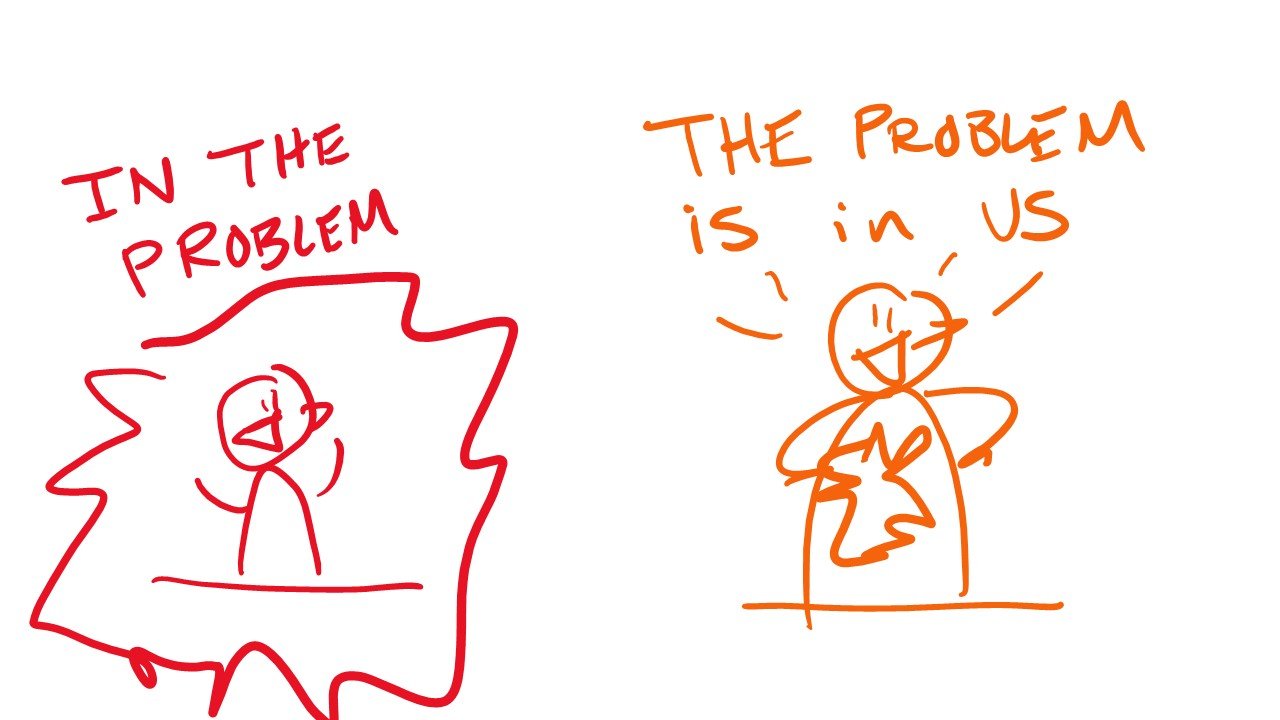Stepping back from the problem
Acting from a Crisis Mode is rarely effective. That’s because when we’re experiencing a crisis we either feel like we’re *inside* of the problem, or the problem is inside of us.
As with many conversations, slowing our inner dialogue process down and avoiding jumping to conclusions is often helpful. This can help us pull ourselves out of the problem, and the problem out from inside of us and look at the challenge from a different perspective - maybe even several perspectives!
The concept of “in the problem” vs “the problem is in us” are from my coaching mentor, Robert Ellis. The sketches above are modeled after his and his work in Coaching from Essence.
The sketch below is inspired by an exercise Erin Warner hosted during my Facilitation Masterclass. Erin had the attendees visualize their biggest challenge, and asked them to visualize walking around that challenge, while physically moving in our spaces. Walking around our challenge is powerful - creating movement helps us get unstuck.
Once we’ve done some of that work, inviting others into the challenge in a more strategic way can be a lot easier.
It was Shakespeare who famously wrote in Hamlet:
“There is nothing good or bad but thinking makes it so.”
I have a favorite quote from the same play that is a slightly weirder way to say the same thing:
“I could be bounded in a nutshell, and count myself a king of infinite space – were it not that I have bad dreams.”
All of which is to say: it is often our own beliefs and perspectives that make life challenging - or amazing.
Living in a tiny space (a nutshell) is only bad if we want something more/different.
So, having a process to examine our own beliefs about a problem, challenge or crisis is worthwhile. And wouldn't you know it, such a process exists! It’s a five-stage exercise called ABCDE, and Dr. Martin Seligman, the father of positive psychology, is credited with creating this exercise. I use it with my coaching clients often, I use it on myself, it’s in my book Good Talk, and I’d love to share it with you.
But first…why does it work?
Your Mind is Racing
I heard a story on NPR about a woman who would leave herself voice messages, talking to herself about her challenges, while she was out walking her dog. Later, she would listen to the recordings. She could then take a step back, and listen to herself, as if she were listening to the problems of a friend. We all know how much better we are at solving other people’s problems than our own.
Many of us are also kinder to other people than we are to ourselves, applying a very different and more forgiving error recognition OS (operating system) with friends or family. Taking her internal conversation outside (changing the interface of the conversation) shifted how she related to it.
Externalizing her inner conversation also slowed down its cadence. Self-talk is fast—really fast.
Researchers have clocked inner speech at a pace of 4,000 words per minute —which is about 10 times faster than verbal speech. The voicemail method slows self-talk down. Like taking in a landscape on a stroll versus on a bullet train, she was able to hear nuances in her own perspective that would be easy to miss otherwise.
Comedian George Carlin said, “The reason I talk to myself is because I’m the only one whose answers I accept.” Even with externalization, there is a tendency to agree with ourselves, especially if there’s an issue we’re passionately, stubbornly stuck on. It can be hard to break the thread of a circling thought. Our internal conversation can cut a deep groove and get stuck in a rut. Here is an exercise that can help you change your mind:
ABCDE: Change Your Mind in Five Easy Steps
Are you willing to attempt to disagree with yourself? The thread of this conversation is designed to guide you through a discussion with yourself, and invite you to take more sides in the conversation. Using a “paper interface” for this self-conversation can slow the conversation down and get everything out of your head.
The exercise can also clarify the impact of the stories you’re telling yourself and generate alternatives.
Grab some paper, a pen and a timer. Give yourself five minutes to brain-write (free-association journaling) each step.
Adversity: Capture a detailed, fact-based who/what/when/where of a challenge you’re struggling with. For example, if you’re upset that someone cut quickly in front of you while driving, the adversity is just “I got cut off on the highway.”
Belief: What was running through your mind when the adversity happened? What’s looping through it now? Your belief, in this case, might be that the driver who cut you off is a jerk, inconsiderate, even dangerous.
Consequence: What is the result or impact of your belief on you? Are you mad, sad, or something else? Focus on your own experience.
Disputation: Write down as many alternative interpretations of the facts as you can. Can you find evidence that might dispute your belief? Was the person who cut you off driving to the hospital? Were they having a really bad day? What else could be true?
Energy: Describe to yourself how these alternative beliefs and narratives make you feel. If the energy from one of these options is better, invite yourself to experiment with it more.

